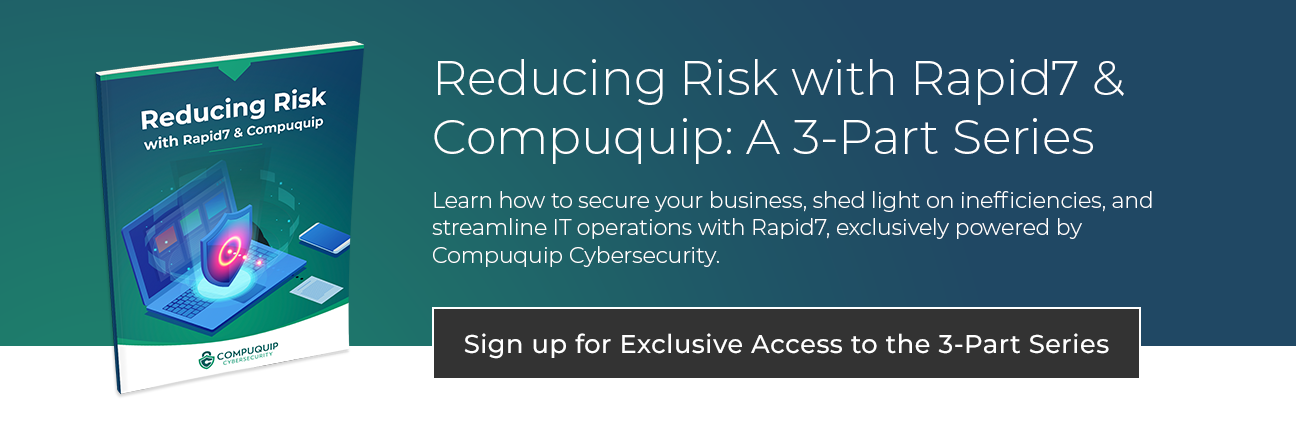Building Enterprise Security Architecture for Business Protection | CQ
Did you know that cybercrime has increased by over 600% since the start of the pandemic in 2020? With cybercriminals exponentially increasing in number and sophistication, your enterprise needs to have a reliable and comprehensive security architecture in place now more than ever.
The security architecture used by your enterprise is the basis of your cybersecurity measures—including the tools, technologies, and processes you use to protect your business from external threats.
However, to get the best results from these tools and policies, they need to be part of an overarching enterprise security architecture framework that helps to define what all of these measures are, the details regarding their uses, and how to integrate changes in the future so your organization has a solid and consistent security architecture design.
Quick Links:
- What Is Security Architecture?
- Phases of the Security Architecture Process
- 4 Benefits of Security Architecture
- Key Attributes of Security Architecture
- What Is Security Architecture and Design?
- Examples of Security Architecture Frameworks
- How to Build a Strong Security Architecture Framework
What Is Security Architecture?
While security architecture has many definitions, ultimately it’s a set of security principles, methods, and models designed to align with your enterprise’s objectives and help keep your organization safe from cyber threats. In other words, security architecture translates the business requirements to executable security requirements. Since each organization is different, every security architecture framework has to meet unique needs and might look different from one business to another.
Phases of the Security Architecture Process
The four main phases of constructing a security architecture are as follows:
Risk Assessment
During the initial phase, the architect evaluates the business influence of vital assets, the potential odds of an attack, and the effects of vulnerabilities and security threats. Risk assessments provide a comprehensive overview of the current state of your enterprise’s cybersecurity posture; you don’t know where to go if you don’t know where you’re starting!
Design
Following the risk assessment phase, the design and architecture of security services, which facilitate business risk exposure objectives are developed by the architect. This is essentially the roadmap for how to handle or fortify your business’s cybersecurity infrastructure and what measures need to be taken for enhanced protection.
Implementation
Upon creating an overall plan, this next phase deals with putting steps into action. Security services and processes are implemented, operated, and controlled; assurance services are designed to ensure that the security policy and standards, security architecture decisions, and risk management are mirrored in the real runtime implementation.
Operations & Monitoring
This final phase encompasses the subsequent day-to-day processes, such as threat and vulnerability management and threat management. Here, measures are taken to supervise and handle the operational state in addition to the depth and breadth of the system’s security. This concluding phase is just as important as the previous three and ensures continuous security measures are in place and appropriately monitored.

4 Benefits of Security Architecture
How does implementing security architecture benefit your enterprise? Here are a few reasons to justify addressing this cornerstone of your security posture:
1. Fewer Breaches of Your System’s Architecture
The first (and most obvious) benefit of having stronger security is that it leads to fewer security breaches. Many attackers use basic attack strategies that target common cybersecurity vulnerabilities shared by organizations that aren’t as invested in establishing a strong security architecture framework.
By strengthening your security architecture to close these common weaknesses, you can drastically reduce the risk of an attacker succeeding in breaching it. While it won’t stop every attack, you may find that the cost of reinforcing security can be easily recovered when you factor in the cost of a breach. As of 2020, the average cost of a data breach was $3.86 million.
2. Compliance With Key Data Security Standards
Your enterprise is likely required to comply with several different information security standards, such as:
- PCI DSS: The Payment Card Industry Data Security Standard is a major security standard that any business handling payment card information is expected to follow.
- HIPAA: The Health Insurance Portability and Accountability Act has numerous provisions regarding the protection of patient information that insurance companies and healthcare providers need to follow.
- GLBA: The Gramm Leach Bliley Act covers the needs of information security for financial institutions—such as banks and insurance companies—to ensure the safety of their clients’ private data.
- GDPR: The European Union’s General Data Protection Regulation guarantees the rights of “data subjects” of whom your organization may be collecting information; this includes the right to deny the collection of personal data and the right to be forgotten upon request.
These are just a small number of data security standards that an organization might need to follow—some businesses may have to follow multiple standards. Many of these data security standards require a business to maintain a strong and well-monitored security architecture, in addition to specific security requirements.
Maintaining a strong security architecture design included as a core component of your business makes it easier to ensure compliance with these standards. In particular, having an accurate map of your network architecture and the various security measures that are integrated can make it easier to tell whether you are at risk of non-compliance with an important regulation.
3. A Strong Security Architecture Example Demonstrates Trustworthiness
When your business is recognized as an example of an organization with enhanced cybersecurity, that helps your enterprise earn the trust of others. This isn’t just the trust of potential customers, either—it includes potential business partners.
By enacting cybersecurity best practices and having a strong security architecture for your network, you demonstrate your company’s trustworthiness to potential business partners. This can help put you ahead of your less security-conscious peers when you’re competing to be a vendor for a major company—especially if that company has suffered financial and reputational damage due to less secure vendors in the past.
4. Preventing a Loss of Business
Trust is priceless for any business; any enterprise that loses the trust of its customers will quickly find that it doesn’t have customers anymore. A cybersecurity breach often results in a loss of trust from customers in the general public. Studies have found that 29% of businesses that face a data breach end up losing revenue, out of which 38% of organizations experience a loss of 20% or more and are unable to sustain the situation.
With a fortified security architecture, you can keep breaches from happening—or at least limit the severity of the breach so data thieves don’t get millions of customer records all at once. This helps to minimize the risk of losing your customers’ faith, and the loss of business that accompanies such reputational damage.
Key Attributes of Security Architecture
Security architecture for your enterprise should entail a few essential components and qualities, including:
The Capacity for Being Comprehensive
Nobody likes the idea of adding point products to an already bloated security stack. A full picture of what’s happening on the network, at the endpoint, and with the user and device is the kind of contextual information that comprehensive cybersecurity architecture provides.
Therefore, the security products you deploy should provide a full understanding of activity on any network segment, including those not fully owned or controlled by the organization, like in the Cloud. They should also provide a way to correlate net flow, full packet information, and logs inside of a comprehensive platform.
The Ability to Be Fully Connected
On some level, the products you deploy in your security infrastructure should connect with others. This follows the same line of necessitating a comprehensive overview of your enterprise’s cybersecurity posture. If your security architecture isn’t fully connected to each facet of your network, then you’re going to miss important vulnerabilities.
Analyzing Continuously
The saying goes that hindsight is 20/20, but hindsight is a critical capability for security teams. Organizations are still taking a long time to find out that they have been breached; that’s why it’s critical to know and improve your organization’s MTTD and MTTR.
Finding sophisticated security threats in real-time is hard, but not impossible. An approach to security that uses the latest updated threat intelligence and replays historical network traffic and packet data to discover threats that were previously missed is what’s needed.
What Is Security Architecture and Design?
A basic definition of security architecture and design is that it's a systematic approach to improving network security and mitigating risks. As mentioned above, security architecture refers to the systems, processes, and tools in place used to prevent or mitigate attacks; design refers to how the security architecture is built.
Organizations of all sizes have a security architecture—whether they have intentionally applied a design to it or not. Having any kind of technology solution means having to consider your security architecture and design. If your security architecture and design are weak and have a lot of gaps, cybercriminals will have an easier time cracking your systems and causing damage.
Examples of Security Architecture Frameworks
Each enterprise is likely to utilize and implement a different security architecture framework and there are multiple variables depending on your enterprise’s goals and infrastructure.
Your company’s security architecture framework should be customized to some degree in order to address your specific objectives; the most common frameworks include:
TOGAF
The Open Group Architecture Framework, or TOGAF, helps determine what problems a business wants to solve with security architecture. It focuses on the preliminary phases of security architecture, an organization's scope and goal, setting out the problems a business intends to solve with this process. However, it doesn’t give specific guidance on how to address security issues.
SABSA
Sherwood Applied Business Security Architecture, or SABSA, is a policy-driven framework that helps define key questions that must be answered by security architecture: who, what, when, and why. Its aim is to ensure that security services are designed, delivered, and supported as an integral part of the enterprise's IT management. However, while often described as a 'security architecture method', it does not go into specifics regarding technical implementation.
OSA
Open Security Architecture, or OSA, is a framework related to functionality and technical security controls. It offers a comprehensive overview of key security issues, principles, components, and concepts underlying architectural decisions that are involved when designing effective security architectures. That said, it can typically only be used once the security architecture is already designed.

How to Build a Strong Security Architecture Framework
Constructing a strong security architecture framework starts with a few foundational steps:
Start With an Existing Enterprise Network Security Architecture
When in doubt, study what others have done to establish their own enterprise security architectures in the past. There are many different enterprise information security architecture frameworks out there that you can draw inspiration from—though you might notice that there aren’t any established frameworks that fit your needs perfectly, odds are that there are some that are relatively close.
In his LinkedIn article "The Best Framework for Security Architecture,” Senior Security Consultant Pascal de Koning highlights several different architectures and states that the key to finding the best architecture to fit your needs is “to determine what problems you want to solve with the security architecture” and to use that to “develop a security architecture that is effective.”
Basically, instead of using an existing framework as your “start to finish” solution, you can borrow elements of that framework and adapt them to your needs.
Identify Your Specific Needs
Tackling everything all at once might be a little too much, however. Trying to create an entire framework from scratch overnight is a sure-fire way to miss important details and ensure that there aren’t sufficient resources to implement the changes.
Rather than trying to fix everything all at once with a single framework, it can be helpful to identify what your biggest challenges/needs are and use that information to jump-start your security architecture design.
Here’s when performing a network security audit/assessment can help. These assessments can be used to identify specific vulnerabilities that need fixing so you can prioritize the most important issues that have the biggest impact on your network security and regulatory compliance.
This helps you focus your efforts and ease your organization into the changes so your security framework implementation can be carried out without undue strain on your resources.
Get Buy-In for the Cyber Security Architecture Framework from All Levels of Your Organization
One of the keys for any successful network security architecture implementation is getting buy-in to the program from people at all levels of the organization—from the CEO down to the front-line workers handling their daily task lists.
In some ways, getting everyone in the organization to accept and align their daily work with your network security architecture framework can be more important than having the right cybersecurity tools and software programs in place. After all, one of the biggest threats to your business’ network security is the insider who intentionally or accidentally misuses their access.
Gaining buy-in from senior-level personnel and having them model the cybersecurity behaviors outlined in your security architecture framework can be vital for ensuring the long-term success of your cybersecurity initiatives.
After all, if employees detect a double-standard for the enforcement of policies outlined in your network security architecture, they aren’t as likely to keep following the guidelines set forth in your framework for very long.
Be Sure to Clearly Communicate Expectations and Changes Moving Forward
Communication is key for success in many business endeavors, and creating an enterprise security architecture framework is no exception. In fact, you could consider communication a core enterprise security architecture principle because, without it, nobody is going to know what they need to do when they need to do it, and what resources are available to them.
Being able to clearly communicate expectations helps you to ensure that everyone in your organization is equipped to follow your security architecture framework—both by apprising them of the requirements and laying out the consequences of noncompliance for the organization and the individual.
Partner with Compuquip’s Team of Expert Security Architects
Your enterprise needs a reliable, comprehensive, and effective security architecture to protect your assets and reputation. However, just as with any other construction project, it won’t happen overnight. That’s why it’s crucial to start scoping out the extent of your cybersecurity needs as soon as possible. Cybercriminals are already planning their next attack - don’t make it easy for them.
Contact the cybersecurity experts at Compuquip to get help and advice for protecting your business’ interests.

